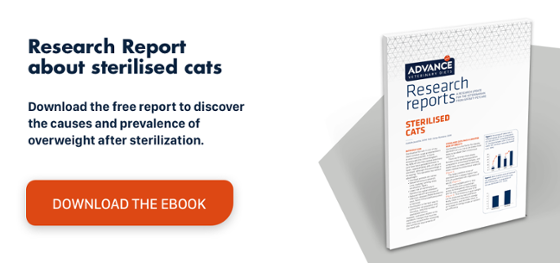Eight predisposing factors to obesity in dogs and cats
In other posts we have discussed nutritional strategies to combat obesity in specific cases as well as products for overweight pets, but we still haven’t focussed on the causes.
1. Age of the pet and the owner:
As the years go by, a pet’s activity level wanes, so they expend less energy. But ageing not only affects pets, as the same thing happens to owners! Over the years, owners change their lifestyle by adopting increasingly sedentary habits and less energetic activities, which they share with their pets: a short stroll instead of a hike, sprawling on the sofa watching a film instead of an afternoon playing games, and so on. So it is essential to adapt the quantity and quality of diets to the energy requirements in each particular case to prevent overweight and obesity.
2. Enclosed spaces:
Cats and dogs living in flats have less space in which to move around. Dogs should be walked outdoors and, if possible, taken somewhere they can run in the open air (parks, the countryside, etc.). It is important to encourage cats to play, to stimulate mobility and set challenges for them to get treats, thus awakening their hunter instincts.
3. Sterilisation:
Sterilised cats and dogs are more than twice as likely to develop obesity. Reasons include a higher food intake (sterilised cats cannot control how much they eat if they are fed ad libitum) and reduced energy requirements.
4. Food during gestation:
In the early stages of foetal development, nutrition plays a crucial role in determining the future kitten’s susceptibility to chronic diseases such as obesity.
5. Breed:
Some breeds have a greater genetic predisposition to obesity. The breed determines the animal’s proportion of lean body mass and fat mass.
6. Lack of activity:
Less physical activity means less energy expenditure. If the cat is very inactive throughout its lifetime, it is likely to develop obesity as it ages.
7. Unsuitable diet:
Providing diets with too much fat or unsuitable home-made diets can trigger weight gain. Animals with a tendency for being overweight, in particular, can benefit from a suitable diet that maintains an ideal weight or encourages weight loss.
8. Comorbidities:
Joint problems, such as osteoarthritis in dogs, are often related to the onset of overweight and obesity. Some metabolic diseases, e.g., thyroid dysfunction, may also be a driving factor for obesity in cats and dogs.
Educating owners to recognise the risk factors early on can facilitate the introduction of measures that prevent overweight and obesity.
Take a look at the body condition assessment tool, where owners will easily recognise their dogs’ status as well as its ideal condition.

